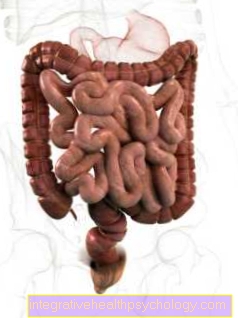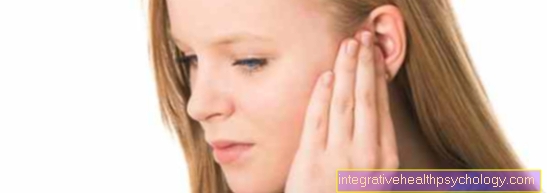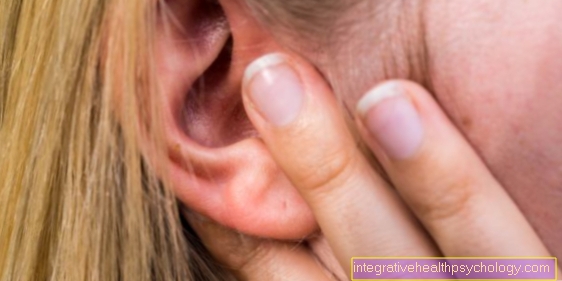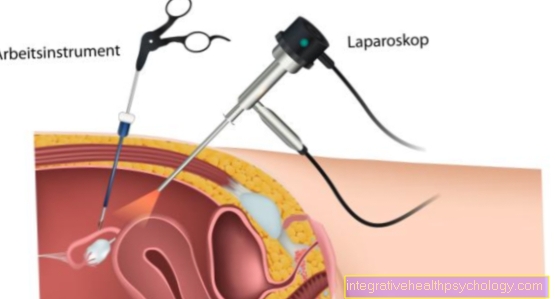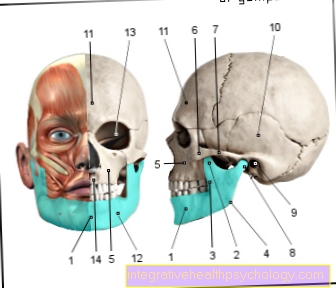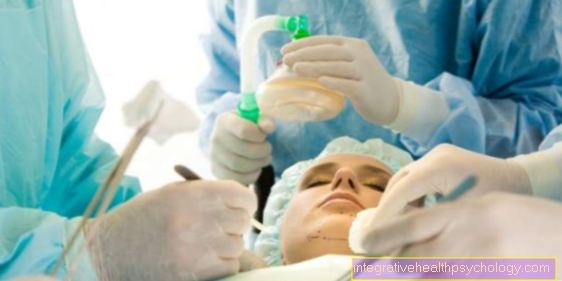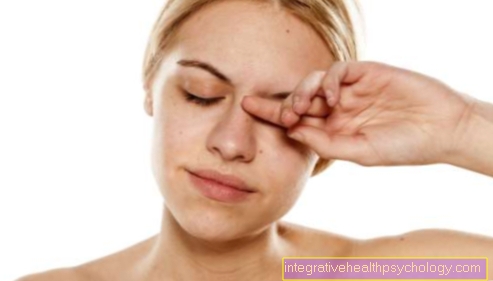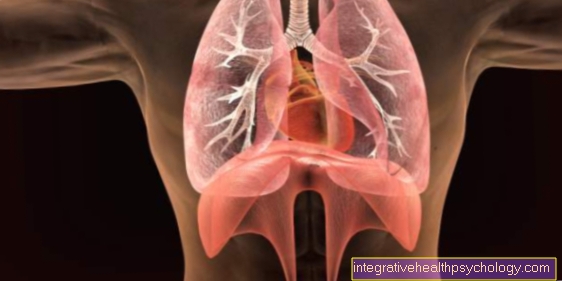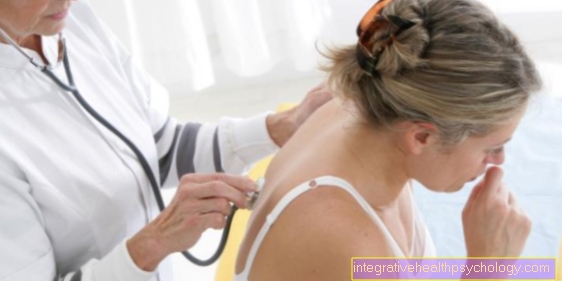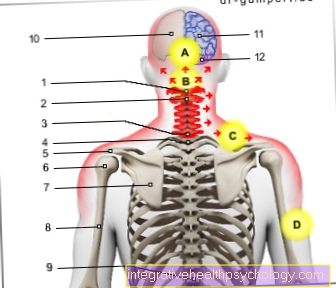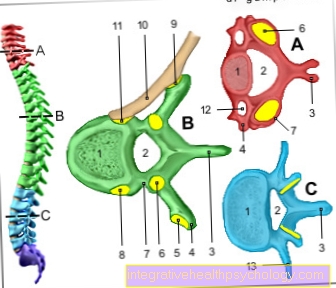Hair loss in children
introduction
Hair loss is the excessive loss of hair, mostly on the scalp. Alopecia is a special form in which a certain area becomes completely hairless.
First of all, one has to keep in mind that there can be a number of causes of hair loss in children. In babies, hair loss prior to permanent hair growth can be completely normal. Often, lying on one head area for too long leads to hair loss. However, if permanent hair growth has started, the hair loss should be clarified if it persists.
The types of hair loss are roughly divided into the following points:
- circumscribed hair loss (limited to a certain area)
- generalized (hair loss occurring diffusely over the entire head)
- scarring
- not scarring
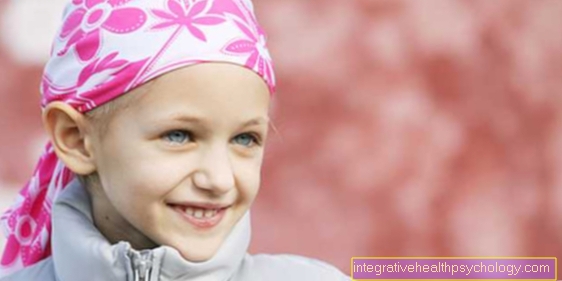
Causes of Hair Loss in Children
The most important causes of hair loss in children are listed below, which are then discussed in more detail. It should be noted that an increased loss of hair is sometimes normal, especially in small children. However, scarring, hair loss in older children or in individual areas should be clarified.
- Hair loss due to a lack of vitamins
- Iron deficiency in the child
- from thyroid disease
- by pathogens
- Autoimmune diseases such as alopecia areata
- self-induced hair loss
Hair loss due to vitamin deficiency
A vitamin or nutrient deficiency occurs on the one hand in areas of famine, but also through illnesses. These can be worms or other intestinal diseases such as Crohn's disease or ulcerative colitis, in which the absorption of nutrients is reduced. Eating disorders like anorexia can also be the cause.
Essential vitamins for hair structure are biotin and the vitamin B complex.
A distinction is made between the following types of vitamin deficiency:
- Vitamin B deficiency: It is very difficult to compensate for a vitamin B complex deficiency.The following products are helpful here: Meat, milk, liver, legumes, whole grain products, wheat germ.
- Vitamin C deficiency: Even with a vitamin C deficiency, hair loss can occur in some cases. This is caused by an iron deficiency, bleeding and cornification of the follicle area. The following foods containing vitamin C are recommended as a dietary recommendation: cabbage, kohlrabi, radish, fruit, lemons.
- Vitamin A deficiency: A vitamin A deficiency but also an excess can cause hair loss. Products containing vitamin A are: butter, cheese, liver, broccoli, spinach, carrots, kale. What is important here is the cooking, chopping and adequate fat intake when the products are consumed.
- Vitamin D deficiency: A vitamin D deficiency can throw the typical hair cycles out of balance, which can lead to hair loss. Some phases are shortened or lengthened. To maintain your vitamin D level, a diet with fish, milk, egg yolks, cod liver oil, liver, margarine, beef and mushrooms is recommended.
- Biotin deficiency: A biotin deficiency can be triggered by artificial nutrition and a very high consumption of raw eggs with the simultaneous intake of antibiotics. In order to achieve a balanced biotin level, you can consume various products such as liver, yeast, nuts, milk, legumes, wheat germ or substitutes.
Another prophylactic measure is sufficient sun exposure on the skin. Because sunlight is essential for the production of vitamin D by the skin. However, you have to be aware that the sun's rays are sometimes insufficient to guarantee the vitamin D content. This is especially true in winter months. It is therefore recommended that children take a vitamin D dose of 400 IU daily.
Iron deficiency and hair loss
Iron deficiency can also be the cause of hair loss. An iron deficiency can result from blood loss and menstruation, after operations or various gastrointestinal diseases. A strictly vegetarian or vegan diet can also promote iron deficiency. Especially in children, there can be an insufficient supply of iron due to the growth phases.
For a balanced supply of iron, you should regularly consume fish, meat and dishes with a high vitamin C content, as this makes iron absorption easier. In addition, it is important to ensure that dairy products and coffee and tea consumption are kept within limits, as these products can increase iron deficiency.
In terms of therapy, oral iron intake can always be considered if the iron deficiency is too severe. It is important to ensure that the iron tablets are served with a drink containing Vit. C, e.g. Orange juice, to be taken on an empty stomach.
There are many causes of iron deficiency. In children, one reason may be the increased need for iron as they grow. Other causes include an unbalanced diet in children with few vegetables and meat. In addition, other gastrointestinal diseases such as intestinal infections, inflammatory bowel diseases or surgery can lead to impaired iron absorption and thus to iron deficiency.
Read our article on this: Consequences of iron deficiency and Iron deficiency in the child
Hair loss due to thyroid disease
Thyroid disease can also play a role in hair growth. As a rule, the thyroid produces two hormones, T3 (L-triiodide tyronine) and T4 (L-tetraiodothyronine). The hormones are responsible for important functions of growth and metabolism.
If the thyroid is underactive, these hormones are no longer produced in sufficient quantities. In addition to tiredness, listlessness, constipation and dry skin, this also has the consequences of hair loss. The hair becomes dull and brittle and the hair density becomes less and less.
The overactive thyroid, on the other hand, manifests itself in an overproduction of thyroid hormones. In addition to symptoms such as palpitations, increased sweating, weight loss and diarrhea, patients also experience accelerated hair growth. However, this means that the hair grows faster, but it grows brittle and thin and usually only reaches a short length.
Because of the other symptoms and the influence of the hormones on the child's metabolism and growth, treatment by an endocrinological internist is urgently recommended.
Hair loss due to pathogens
Hair loss can also be caused by pathogens such as viruses, bacteria and fungi. Most often, however, it comes to an infection with fungi. In general, fungal infections of the scalp manifest themselves in a scaly, circumscribed, inflammatory form of hair loss. Depending on the type of mushroom, hair that has not broken off or broken off is noticeable.
The most common fungal infection is tinea capitis. This is caused by Trichophyton fungi. Tinea capitis is characterized by the appearance of ring-shaped, scaly regions, with the scales on the edge and broken hair or black speckled hair visible in the round area. It can also lead to an attack on the eyelashes and eyebrows. The fungus penetrates the surface of the scalp and attacks the hair shaft. The fungus is contagious and usually spreads quickly in kindergarten. Therefore, care should be taken to ensure that no pillows, hats and brushes are exchanged.
The exact type of fungus can be recognized by a smear and a cell culture. Usually it is the fungi of the Microsporum or Trichophyton.
There are special drugs that can be used against fungi, so-called antimycotics. First, you try to smear the area with antimycotics (imidazole, ciclopirox) locally. If this has no effect, you have to resort to systemically effective drugs (itroconazole, ketoconazole, griseofulvin). However, you have to make sure that ketoconazole can only be used from 2 years and itraconazole from 18 years.
More on this topic: Skin fungus
Circular hair loss: alopecia areata
The classic circular hair loss typically occurs in the disease called alopecia areata. The incidence of this disease is about 0.03-0.1%. Girls and boys are equally affected. This form of hair loss usually occurs suddenly overnight and is circumscribed in a circular shape and does not cause scarring. In addition, the skin area is completely smooth without flaking or broken hair.
Alopecia areata is based on an autoimmune disease. Your own immune system is directed against your own body, for example by forming antibodies against the body's own substances. With alopecia areata, the immune system of the own body is now directed against the hair roots. They consider the hair follicle to be foreign. As a result, the attack of the immune cells creates an inflammatory reaction, which is the cause of the hair loss. However, it is still unclear why only some scalp areas are affected. The autoimmune disease is genetic. The disease can recur and lead to permanent hair loss. Multiple triggers are required for the disease to break out. One of them is inflammation in the body.
In the course of this, the hair may fall out in a series of phases. In addition, you can see a pasty, compressible swelling of the area, but it is not inflamed. So-called comma hairs or exclamation point hairs can be observed on the edge areas. This is short, broken hair that is tapered. In 30% of patients, hair loss is accompanied by changes in the nails. Identity and group membership problems caused by hair loss should not be underestimated, especially after primary school age.
There are 2 forms of alopecia areata:
- Alopecia areata circumscripta
- Alopecia areata totalis
Alopecia areata circumscripta is a single circumscribed area of circular hair loss. Head hair, eyelashes, eyebrows, but also all other body hair can be affected.
Alopecia areata totalis usually results in a complete loss of hair on the head.
The extreme form of hair loss affects all body hair and is also called alopecia universalis.
Other manifestations of the disease are expressed in swelling of the lymph nodes, changes in the nails and the nail bed (sandpaper nails, spotted nails, reddish nail moon). 10-20% of children are also hypersensitive to intolerance and allergies. In addition, white skin disease with 1-4% (vitiligo) and thyroid diseases with 1-2% occur more frequently. Fortunately, in many children in 30-40% of cases, the disease heals spontaneously in the first 6 months. Unfortunately, the disease has a high relapse rate.
Risk factors for the disease are:
- Occurrence before puberty
- Nail change
- Hypersensitivity / allergies
- Autoimmune diseases
- Hair loss on the neck
Read more on this topic at: Circular hair loss
Self-induced hair loss
This is mostly hair loss, which leads to the fact that the patients cause their own hair loss for psychological reasons.
This is particularly the case during puberty or adolescence.
- Trichotillomania: In the form of trichotillomania, the patients try to pull their own hair out. This can be done by plucking, pulling, twisting or rubbing. It can be observed that this form occurs more frequently in girls in adolescence, but more frequently in boys in childhood. Unlimited areas with different lengths of the broken or torn hair are characteristic here. In addition, a pull test is negative and skin hemorrhages can be seen microscopically, although there is no inflammation. The cause is considered to be stress and anxiety in the child or the loss of a loved one or the divorce of the parents.
- Trunnion emnomania: Another form of self-inflicted hair loss is funnel emnomania. Here the patients cut their own hair.
- Traction alopecia: A very special form of hair loss in children is traction alopecia. This occurs especially in children with “ponytail hairstyles”, in which a pull is released on the front section of hair. Hence, hair loss occurs on the front hairline. Further mechanical irritation to the hair is caused by excessive combing and braiding. Hair shampoos or blow-drying the hair too hot can also promote hair loss.
Pitted forms of hair loss in children
Scarring forms of hair loss can be deep-seated fungal infections or blistering skin diseases such as epidermolysis bullosa or lichen planus follicularis. Immune diseases such as lupus erythematosus can also cause scarred hair loss.
Aplasia cutis congenita is a hereditary form of pitted hair loss. Here you can see an ulcer after birth, which heals with scarring and hairlessness.
therapy
Before the therapy can be started, one should check whether there are inflammatory foci that could impair the success of the therapy and whether other metabolic diseases that could also be the cause have been excluded.
Depending on the severity and phase of the disease, one tries to proceed as systematically as possible. In the acute phase you start with a cream containing cortisone, which is spread on the affected areas of the skin. After 4 - 6 weeks you look at the development of the hair loss. If this continues, a therapy with the active ingredient dithranol is attempted. Usually only short-term relief from the disease is obtained because the relapse rate is very high. In at least 50% of the cases there is a spontaneous healing. Since the prognosis for a cure is not very high, psychotherapeutic counseling or support is also recommended, as those affected usually suffer from the consequences of hair loss.
In addition, iron and zinc supplements can be added for 3 to 6 months if necessary, since iron deficiency and zinc deficiency can also be the cause of hair loss or promote it.
Read more about this under: Hair growth in the baby or Accelerate hair growth
diagnosis
The diagnosis takes place in interaction with the Survey of the medical history and the physical exam. Proof of the above-mentioned characteristics of hair loss is decisive for the diagnosis.
An inflammatory change around the hair shaft can be seen under the microscope, as well as the occurrence of excessive telogen hair, which represents a hair shape determined in the hair cycle.

